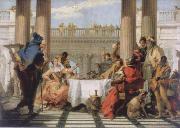Wholesale Oil Painting No Minimum |
|||||||||||
|
|
|||||||||||

|
|||||||||||
|
|
|
||||||||
Giambattista Tiepolo1696-1770 Italian painter, master of Venetian school. Tiepolo was famous in his own lifetime as a superb painter in fresco and a brilliant draftsman. A highly inventive artist, he could create spectacular effects in difficult sites, from the narrow gallery at the patriarchal palace at Udine in the mid-1720s to the vast staircase ceiling in the Residenz at Werzburg in the early 1750s. Contemporaries recognized his spirited, dynamic approach to subject matter and his frankly sensuous manner of painting. Tiepolo is comparable in his restless energy and imaginative power to Peter Paul Rubens, and essentially he worked with a similar baroque language of myth, allegory, and history, which he infused with a sense of freshness and modernity. His approach to religious art is characterized by candor and naturalism, while he was responsive to the different concerns of patrons and viewers at a time when the church was faced with new kinds of devotion and criticism. With the advent of neoclassicism, Tiepolo's art fell from favor: In an age that prized archaeological correctness, rationality, and ideals of improvement, his witty, Veronese-inspired conception of historical or classical subjects seemed frivolous, while his visually seductive qualities were seen as inimical to the serious intellectual aims of the new art. Nevertheless, his drawings and oil sketches continued to appeal to collectors, including Antonio Canova. The son of a Venetian shipping merchant, Tiepolo was apprenticed in 1710 to Gregorio Lazzarini (1655C1730), an artist of international reputation patronized by prominent Venetian families. Before becoming an independent master, he worked in the household of Doge Giovanni Corner; members of the Corner family were to be his most steadfast and liberal patrons. Lazzarini encouraged his pupils to study Venetian sixteenth-century art, and Tiepolo made drawings of some famous works for publication in Domenico Lovisa's Gran Teatro di Venezia of 1717. His early involvement with the thriving Venetian engraving and publishing world was renewed in 1724 when he made drawings of antique sculpture as illustrations for Scipione Maffei's Verona Illustrata, an experience that gave Tiepolo an imaginative empathy with fragmentary antique remains, which recur in his drawings, etchings, and paintings. As well as studying the art of the past, Tiepolo looked to the tenebrism of Federico Bencovich (1677C1753) and the realism and monumentality of Giovanni Battista Piazzetta (1682C1754). In 1719 Tiepolo married Cecilia Guardi, with whom he was to have nine children. By then, the artist was working for a network of mercantile and noble patrons on religious and secular subjects. |
||||||||
|
|
||||||||
The banquet of the Kleopatra
The banquet of the Kleopatra Painting ID:: 45436 |
mk186
1743/44
Melbourne nationally Gallery of Victoria mk186 1743/44 Melbourne nationally Gallery of Victoria |
|||||||
|
|
||||||||
|
ALLORI Alessandro Italian Mannerist Painter, 1535-1607 Born in Florence. After the death of his father in 1540 he was brought up and trained in art by a close friend, often referred to as his 'uncle', the mannerist painter Agnolo Bronzino, whose name he sometimes assumed in his pictures. In some ways, Allori is the last of the line of prominent Florentine painters, of generally undiluted Tuscan artistic heritage: Andrea del Sarto worked with Fra Bartolomeo (as well as Leonardo Da Vinci), Pontormo briefly worked under Andrea, and trained Bronzino, who trained Allori. Subsequent generations in the city would be strongly influenced by the tide of Baroque styles pre-eminent in other parts of Italy. Freedburg derides Allori as derivative, claiming he illustrates "the ideal of Maniera by which art (and style) are generated out of pre-existing art." The polish of figures has an unnatural marble-like form as if he aimed for cold statuary. It can be said of late phase mannerist painting in Florence, that the city that had early breathed life into statuary with the works of masters like Donatello and Michelangelo, was still so awed by them that it petrified the poses of figures in painting. While by 1600 the Baroque elsewhere was beginning to give life to painted figures, Florence was painting two-dimensional statues. Furthermore, in general, with the exception of the Contra Maniera artists, it dared not stray from high themes or stray into high emotion. The banquet of the Kleopatra mk186 1570 Florence, Palazzo Vecchio, Studiolo di Francesco I de' Medici |
||||||||
|
|
||||||||
|
Prev Next
|
||||||||
|
|
||||||||
|
Related Paintings to ALLORI Alessandro :. |
||||||||
|
|
||||||||
|
CONTACT US |

